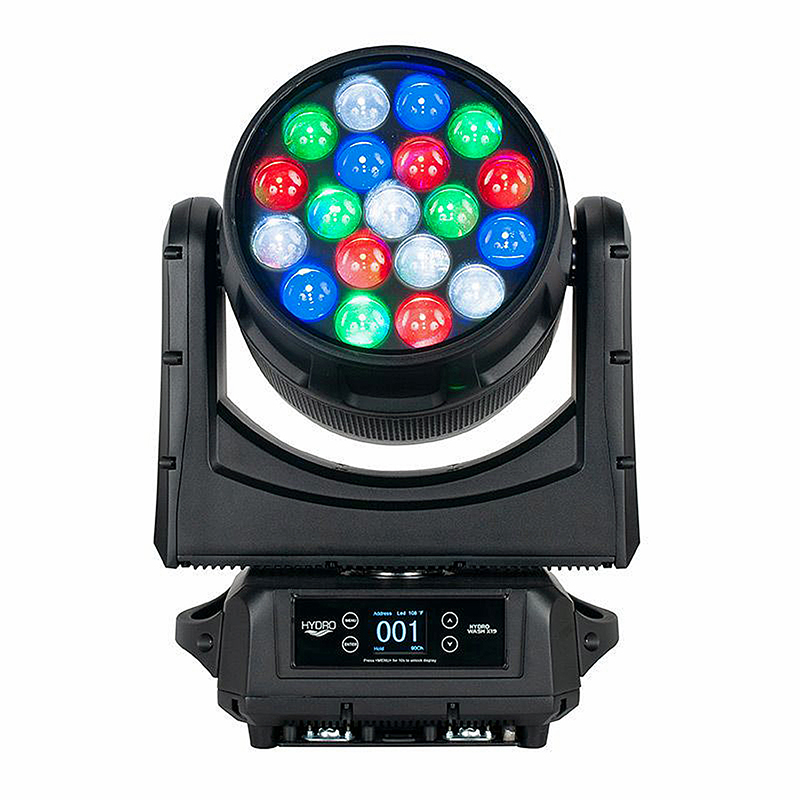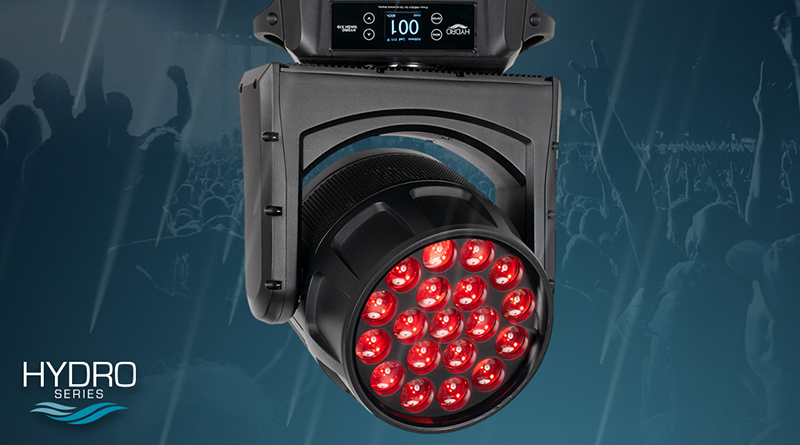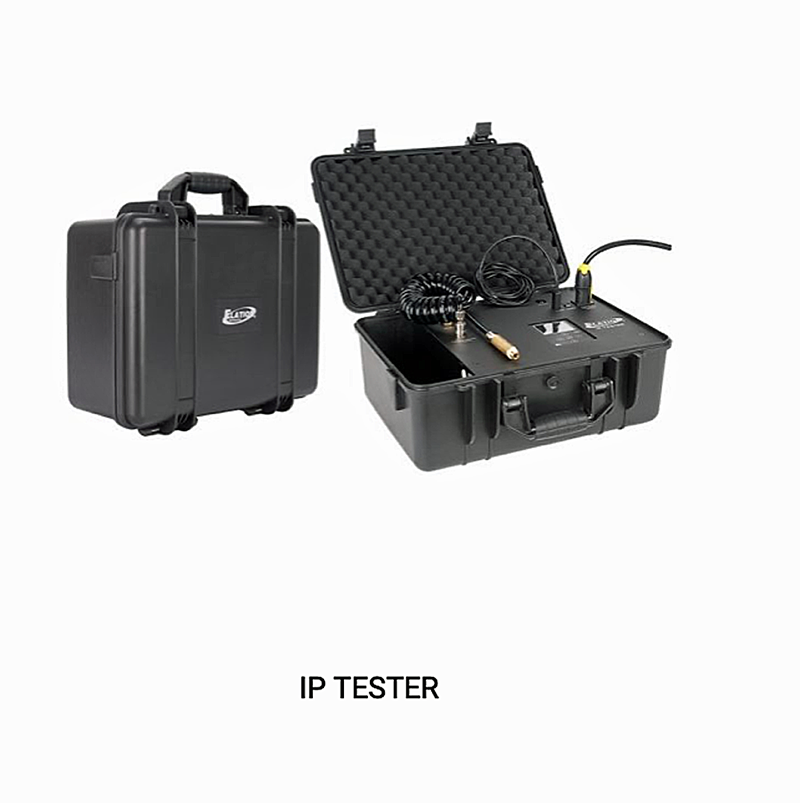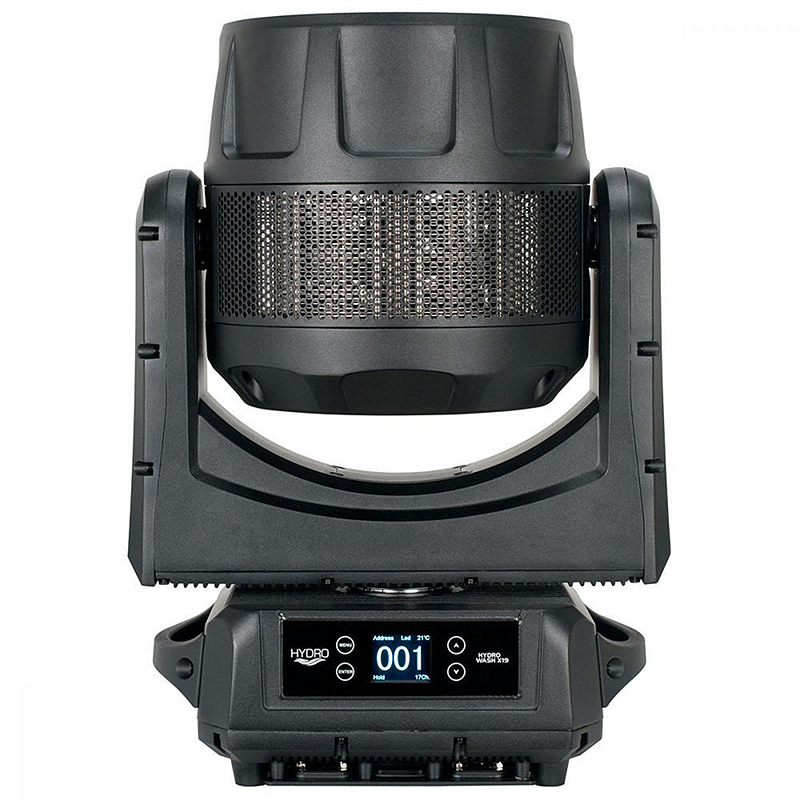
ADJ has added another winner to their Hydro range of IP65 weather protected moving lights with the Hydro Wash X19. The big brother to the X7 model, which debuted a year ago, this unit takes the range to an unprecedented level of brightness via 760 watts of RGBW power.
Sporting 19 individual cells of 40-watt Osram emitters on a flat face in a medium sized fixture, ADJ has them arranged in three rings, counting the center pixel as one. As I program this fixture I remind myself that ADJ is committed to delivering mid-level lighting gear at an affordable price. But the more I play around programming it, the more cool things I am able to do. This is not a one-trick pony, unless you wish it to be.

The Hardware and Look
My first attraction to this fixture is the stealth look to the metal weatherproof shell and base. The extra protection comes with the price of the weight, as this fixture weighs 53 pounds. I can lift it out of a case by a couple side handles that are part of the thin base, but note there are no tilt locks on the yoke.
With this fixture come two separate valves, one located above the fuse on the plug in panel of the base and the other on the head itself. The valve has a cover on it that, once unveiled, enables the technician to screw in an Elation IP tester kit (sold separately). This kit will apply the correct pressure inside the unit. It will also test the suction, making sure the fixture is 100% sealed correctly anytime it has been opened up for service.

I’m not going to hose this fixture down with water in the parking lot; their advertisement already does that. ADJ says the casing eliminates any worries from sand, dirt, grime and even beer, making it just as valuable inside certain nightclubs as out and I have no reason to doubt them. There is a front clear lens that protects the individual lenses housing the 4-in-1 emitters.
One side of the base holds all the panel mount connectors which include In and Out AC plugs, In and Out 5-pin XLR connections for DMX and an RJ45 connector to accept Art-Net or Kling-Net. It also accepts RDM commands. All these connectors are sealed with weatherproof rubber caps, and users are required to use appropriate IP65 connectors on all cables to ensure the weatherproof operation of the fixture.
Multiple fans are well concealed in the fixture, which I am not opening up. The head is fully cylindrical in shape with air vents encapsulating 360° of it. I can feel the heat blowing out one side, which is warm to touch, while assuming the colder side is for the air intake. One has options to change fan speed, but never to turn it off. The menu gives users the option of a high speed fan or an automatic one. I test the automatic one, and the fixture is totally silent until you turn a dimmer on. The more LEDs one turns on, the louder the fans get. The noise level is acceptable for any live concert, nightclub or outdoor event.

Taking Control
I test the fixture out in a basic 16-channel mode to start, via some DMX cable from an Onyx console from Obsidian Control Systems. I do note that this fixture can be operated wirelessly via the WiFly EXR Wireless system built into the fixture, a system that can operate up to 2,500 feet of the operating signal in a straight line-of-sight.
This is the mode a basic beginner might use, one that treats the fixture like a basic LED wash fixture as opposed to a multipart one, to adjust dimmer, pan, tilt, strobe, RGBW and zoom. No individual pixel control here, but I note that all modes come with extra control channels that can effect dimmer curves, dimmer delay times, pan/tilt speeds and various control settings, such as PWM values and fixture resets.
The X19 pans 540° at an average speed, and the 230° tilt runs equally as fast. The fixture can accept commands and move evenly from one focus position to another, and I notice that the motors are quite strong. It takes quite an effort to physically knock one out of focus at all, and it just jumps back to its normal position if something bumps into it. The processing on slow movement effects is acceptable.
The dimming is smooth in the default mode as expected, but users have six different dimmer curves they can choose from. The fixture does execute sync, random and pulse strobe modes that are simple to access. It’s a basic fixture at an affordable price, and while I wasn’t looking for any bells and whistles, I sure found ‘em in the 88- and 90-channel modes.
Moving On Up
The 88-channel mode separates the head from the individual LEDs, and any seasoned programmer would take advantage of this mode as it gives one individual access to the RGBW levels on every individual pixel. Most lighting consoles will include a virtual dimmer to access the individual cell’s dimmer levels. To turn on individual pixels, I have to think slightly backwards here. I need to bring all the LED cells to full via the master dimmer channel, then turn off the cells I do not wish to see individually. Without the master dimmer at full, no cells will emit any light. This is the preferable control mode that SDJ and Elation prefer.
In this mode, I quickly make some groups and write color and dimmer chases. They are performing flawlessly and do well with the effects engine commands. Next up, I test the 90-channel mode, which offers me two additional parameters, a virtual color scroller with 29 premade colors that are set up in a sequential order, with shades of magenta, blues and ambers. I can scroll between colors offering a half color of sorts. I can also rotate the whole wheel in a color roll at variable speeds and directions.
The other extra channel offers what ADJ is calling color macros. These are essentially 64 different premade colors to choose from for the whole face. There are no separate groupings of cells in configurations such as rings, odds, evens etc. in various colors as one might expect.
Color-wise, The red, green, blue and white LEDs are all well saturated, dare I say more than many of their competitors. I meter the CRI and come up with a value of 84, which will account for the good rich colors. I will admit I am unable to mix a yellow color without a hint of green in the overall hue, but mixing lavenders and pink hues are a cinch. The full green emulates a L124 medium hue.
I can mimic a random color strobe easily with the effects engine, and individual cells flicker and come to life. Another great attribute about this fixture is its ability to pixel map the individual cells from any outside source by use of the RJ45 connector and Kling-Net feeding it the video. Random color chasing via an effects engine can easily create a fiery lit scene on stage.
There is a separate channel for CTO. The fixture can run in a wide variety of whites. My fixture profile starts out with the fixture defaulted to its native 6400°K color temperature at zero. As soon as I increase the level on the CTO channel, it pops to 2700° and a nice warm CTO. Increments will increase it accordingly until the output reaches 7000°K. I note that the moment I add any value to this color temperature channel, it immediately removes any existing red, green or blue hues, as it reckons the user wishes to achieve a white beam with a variable color temperature. ADJ and Elation prefer to use this option on all of their LED wash lights as opposed to adding the color temperature to existing mixed colors.
The zoom range works well for this fixture, going from an almost collimated 6° up to 40°. It moves quickly enough that one can make a nice zoom chase.
The fixture comes in a black matte finish and appears easy enough to work on should repairs become necessary over time. Size-wise, it’s a medium, taking up less than two feet in height with a width of 15.25”. The self-sensing power supply will take anywhere from 100-240 volts and has a maximum power draw of 990 watts. The four-button LCD control screen on the base is simple to navigate without instructions.
At a Glance
Bright and Weather-Ready
This medium-sized fixture packs a punch with 760 watts of power from 19 RGBW cells. With its good-looking beam, weatherproof casing and affordable price, this fixture could serve as a good addition to any outdoor exhibition or concert as well as a club install.
ADJ Hydro Wash X19
PROS: IP65-rated, Individual control of each pixel if wanted, saturated colors, fast zoom.
CONS: CTO color correction only works with white light.
FEATURES
- IP65 Weather Protection
- Motorized Focus (6° to 40°)
- WiFLY Wireless DMX
- Fine Pan/Tilt and Dimming Control
- Six Dimmer Modes, LED Refresh Rate and Gamma Control Settings
SPECS
- Light Source: 19 Osram 40W RGBW 4-in-1 LEDs
- Total Wattage: 990W
- Zoom Range: 6° to 40°
- Weight: 52 lbs.
- Size: 15.25 x 11 x 20.75”
- MSRP: $4,995.95
Manufacturer: ADJ
More Details: www.adj.com


